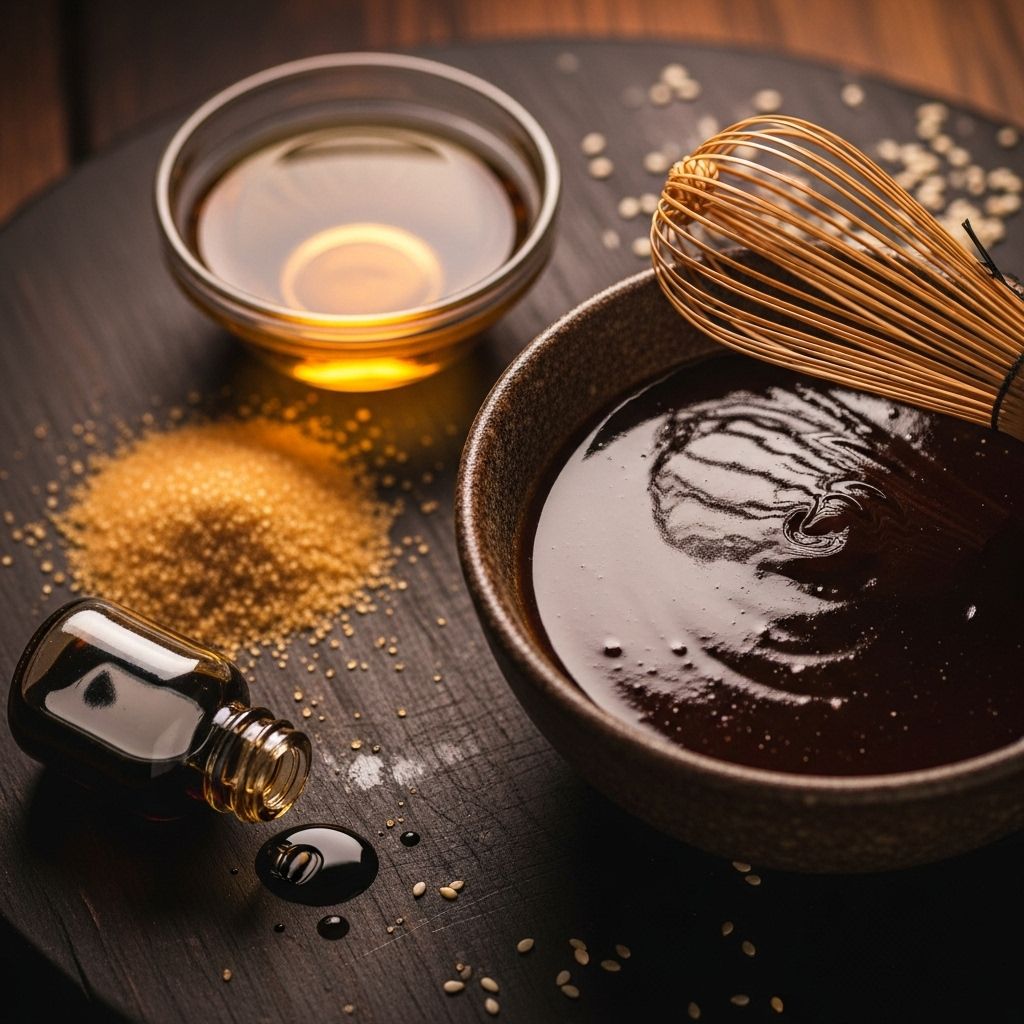Eel Sauce Recipe: 3-Ingredient Sweet-Savory Sushi Glaze
Learn to make authentic eel (unagi) sauce at home with simple ingredients, tips, and serving ideas.

Image: HearthJunction Design Team
How to Make Eel Sauce (Unagi Sauce): The Ultimate Sweet and Savory Sushi Glaze
If you’ve ever enjoyed sushi drizzled with a glossy, sweet-savory sauce, you’ve likely tasted eel sauce, also known as unagi sauce. Often found in Japanese cuisine, this rich, flavorful condiment is a staple in sushi restaurants and can be made easily at home with just a few ingredients. Whether you’re craving a topping for grilled eel, a dipping sauce for tempura, or a glaze for stir-fries, this guide will walk you through every step, provide essential tips, and answer your most common eel sauce questions.
Table of Contents
- What Is Eel Sauce?
- Eel Sauce Ingredients
- Step-by-Step Directions
- Tips, Substitutions & Variations
- Serving Suggestions
- Storage and Shelf Life
- Frequently Asked Questions (FAQs)
What Is Eel Sauce?
Eel sauce, despite its name, contains no eel. Known in Japan as unagi no tare, it is a sweetened, soy-based glaze most commonly used as a topping for grilled eel (unagi) and sushi rolls. It adds depth and umami, combining salty, sweet, and savory notes in a sticky, pourable sauce. In restaurants, some versions may include fish stock or dashi for an extra layer of flavor, but the core recipe is vegetarian and widely enjoyed for its versatility.
Key Characteristics:
- Glossy, dark brown color
- Sweet, salty, and a little tangy
- Thick and sticky texture
- Umami-rich flavor
- Often used on sushi, grilled meats, and as a dipping or drizzling sauce
Eel Sauce Ingredients
Authentic eel sauce uses just three ingredients, all of which are easy to find at most grocery stores or Asian markets. Here’s what you’ll need:
- Soy Sauce: Provides the salty, umami-rich backbone. Use a good quality soy sauce for best flavor. Gluten-free options are available, such as those from Kikkoman.
- Sugar: White granulated sugar offers the classic sweet note, but brown sugar can be used for a deeper, more caramel-like taste.
- Mirin: A sweet Japanese rice wine that gives the sauce its signature sheen and mild acidity. If you don’t have mirin, use dry sherry as a substitute, or mix rice vinegar with a little extra sugar for an alcohol-free alternative.
| Ingredient | Amount (For 1 Batch) | Notes |
|---|---|---|
| Soy sauce | 1/2 cup | Use regular or gluten-free |
| Sugar | 1/2 cup | White or brown |
| Mirin | 1/2 cup | Or substitute as noted above |
Optional Additions:
- Apple cider vinegar can be used for added tang, especially in recipes omitting mirin.
- Cornstarch mixed with water can thicken the sauce further if desired.
- Coconut aminos can substitute for soy sauce for a soy-free version (reduce simmering time when using).
Step-by-Step Directions
Making eel sauce at home is quick and straightforward. Follow these steps for perfect results every time:
- Combine Ingredients:
- Add the soy sauce, sugar, and mirin to a small saucepan.
- Stir until the sugar is mostly dissolved.
- Heat and Simmer:
- Place the saucepan over medium heat.
- Bring the mixture to a gentle boil, then reduce heat to low.
- Let it simmer uncovered for 5–15 minutes, stirring occasionally. The sauce will begin to thicken and darken as the sugars caramelize.
- Check Consistency:
- The sauce is done when it’s thick enough to coat the back of a spoon but still pourable.
- If using cornstarch, make a slurry and whisk it in during the last minute of cooking for a thicker glaze.
- Cool and Store:
- Remove from heat and let cool to room temperature. The sauce will continue to thicken as it cools.
- Transfer to a squeeze bottle or jar for easy serving and storage.
Pro Tip: Don’t over-reduce! As eel sauce cools, it thickens more. If boiled too long, it can become too sticky or hard to pour.
Tips, Substitutions & Variations
- For a Thinner Sauce: Simmer for just 5–6 minutes.
- For a Thicker Sauce: Simmer for up to 10–15 minutes, but monitor closely to avoid burning or over-thickening.
- Substitute for Mirin: Use dry sherry (equal amount) or a mix of rice vinegar + extra teaspoon of sugar for an alcohol-free version.
- Soy-Free Option: Coconut aminos work well but require a shorter simmering time (about 1 minute) as they thicken faster.
- Vinegar Add-In: For extra tang, try recipes that use apple cider vinegar instead of mirin.
- For Added Umami: Some restaurants add dashi or fish stock. This is optional and not typical of vegetarian/store-bought versions.
Serving Suggestions
Eel sauce is incredibly versatile and not just for sushi! Here are some delicious ways to enjoy your homemade batch:
- Sushi: Drizzle over sushi rolls like dragon rolls, eel rolls, or spicy tuna rolls.
- Grilled Eel (Unagi): Traditional pairing, brushed over grilled eel fillets.
- Tempura: A sweet-savory dip for fried tempura vegetables or seafood.
- Grilled Meats & Seafood: Brush over chicken, shrimp, or salmon for a Japanese-inspired glaze.
- Stir-Fries & Noodles: Toss with stir-fried veggies or use as a sauce for yakisoba or lo mein.
- Rice Dishes: Drizzle over steamed rice or poke bowls for instant flavor.
- Dipping Sauce: Serve alongside dumplings, spring rolls, or even roasted vegetables.
Storage and Shelf Life
- Let cool completely, then transfer to an airtight jar or squeeze bottle.
- Store in the refrigerator for up to two weeks; some home cooks find it lasts even longer.
- For best texture, bring to room temperature before using, or gently reheat if it becomes too thick.
Frequently Asked Questions (FAQs)
Q: Is eel sauce actually made from eel?
A: No. Despite its name, eel sauce contains no eel. The name comes from its classic use as a glaze for grilled eel (unagi) in Japanese cuisine. Most store-bought and homemade recipes are vegetarian, based on soy sauce, sugar, and mirin.
Q: Can I make eel sauce without mirin?
A: Yes. Substitute dry sherry, or mix rice vinegar with extra sugar for an alcohol-free version. Apple cider vinegar can also add tang in mirin-free recipes.
Q: Is eel sauce gluten-free?
A: It can be, if you use gluten-free soy sauce or tamari. Always check packaging if you have dietary needs.
Q: What does eel sauce taste like?
A: Eel sauce is sweet, salty, savory, and slightly tangy, with a thick, glossy texture.
Q: Can I freeze eel sauce?
A: Freezing is not recommended as it may alter the texture, but the sauce keeps for weeks in the refrigerator.
Q: How can I thicken eel sauce?
A: For a thicker sauce, simmer longer. Alternatively, whisk a cornstarch slurry (1 tsp cornstarch mixed with 1-2 tsp water) into the simmering sauce, stirring until thickened.
Q: What is the typical ratio for ingredients in eel sauce?
A: The standard restaurant ratio is 2:2:1 for soy sauce:mirin:sugar (e.g., 2 cups soy sauce, 2 cups mirin, 1 cup sugar).
Nutrition Information (Estimated per Tablespoon)
| Calories | Sodium | Carbohydrates | Sugar |
|---|---|---|---|
| 35–45 | 400–600mg | 8g | 6g |
These values are approximate and will vary depending on brand and exact proportions.
Conclusion
Homemade eel sauce is a simple way to elevate your Japanese meals at home. With just three main ingredients and a few minutes, you can whip up a glossy, restaurant-style sauce perfect for sushi, stir-fries, and more. Play with the basic formula to match your tastes and dietary needs, and don’t be afraid to use it on dishes beyond Japanese cuisine. Once you try making it from scratch, you’ll always want a batch in your fridge!
References
Read full bio of Shinta












